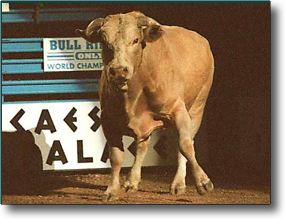Susan Nance, professor of US history at the University of Guelph, presented a fascinating paper “A Star is Born to Buck: On the Development of Rodeo Bulls in the 1990s” at the Rural History Roundtable today. Although Nance’s past work has touched on topics such as tourism under the Ottoman Empire and religious parades in interwar Chicago, her more recent work has focussed on accounting for the absence of animal’s stories in historical scholarship. The subject of her talk today is a transnational study of rodeo’s and performance with an emphasis on the contribution of the animal – most specifically ‘Bodacious’, the ‘World’s Most Dangerous Bull.
“A Star is Born to Buck: On the Development of Rodeo Bulls in the 1990s” at the Rural History Roundtable today. Although Nance’s past work has touched on topics such as tourism under the Ottoman Empire and religious parades in interwar Chicago, her more recent work has focussed on accounting for the absence of animal’s stories in historical scholarship. The subject of her talk today is a transnational study of rodeo’s and performance with an emphasis on the contribution of the animal – most specifically ‘Bodacious’, the ‘World’s Most Dangerous Bull.
Nance explores the story of Bodacious and asks some probing questions of the nature of the role of the bull in the rodeo circuit.
Briefly, Bodacious was born in 1988. Although he didn’t demonstrate an immediate tendency to buck (we learn that bucking is a far from universal tendency amongst bulls – only 1 in ten will buck if ridden) after three years on the range he joined the professional circuit. He quickly gained the moniker ‘the Yellow Rail’ and a reputation for, particularly fierce behavior. In rodeo parlance, he may have started as a ‘sweet’ bull, he became ‘rank’ and finally became an eliminator. Nance emphasizes that Bodacious was always referred to as a he and not an it, was seen as an athlete in the ring, and was subject to a code of behaviour between the rider and the bull.
The ride is an equitable arrangement where each participant receives and individual score and has an opportunity to demonstrate dominance – the rider when mounted and the bull once he has thrown the cowboy. Bodacious was a tough ride early on, throwing riders with regularity, only eight times in his career were rider able to remain on his back for the full eight seconds necessary to gain points themselves. Nance focusses on notice of behaviour and whether the animal seems capable of making choices in this process. Its seems clear from Bodacious’ performance that he did change his behavior over time and in doping so violated this unwritten code. Bodacious was noted for his instinct to spring right out of the chute and to with a certain grace pitch from side to opposite side sensing the shift in the cowboy’s balance. However, within a few years, Bodacious also demonstrated a new move: a seemingly deliberate performance where he would sense the rider being tossed forward, and immediately throw his massive head back to collide with the rider. He did this on multiple occasions finding the rider’s face – crushing it horribly. When three-time world champion Tuff Hedeman refused to ride Bodacious after he having finished Hedeman in this way the previous year, the bull’s career quickly ended. When Bodacious died in 2001 at the Andrew’s Texas ranch, the event was covered widely in the world press. The bull was a star athlete and a commercial success. Incidently, I note that Bodacious’ notoriety has also sparked interest from those pointing to rodeo riding as animal abuse.
For Nance, the story of Bodacious touches on many fascinating aspects: How has animal behaviour shaped capitalism and performance? What is the nature of the negotiation between corporate sponsorship and traditional performance? How much of the notoriety was in fact a part of the animal’s behaviour and how much promotional mythology and marketing?
I was quite taken with Nance’s presentation and her ability to truly bring a Bodacious to life and to capture the sense of the animal having a career and developing as part of a perceived role. What a fascinating area of investigation.
